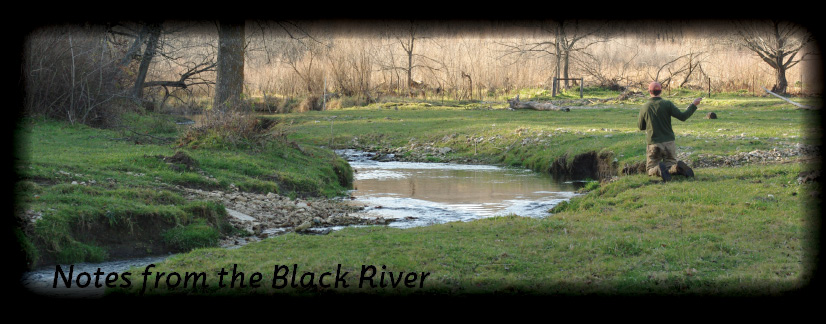

Howdy folks,
I don't have a ton of experience fishing for stream trout during winter. But the more I do it, the more I'm finding out that there are two basic ways to go about catching fish: 1) casting to 'pods' of hundreds to thousands of stagnant fish (probably recently stocked), and 2) stalking smaller groups of more 'wild' fish on smaller water with more structure (rocks, trees, etc...).
I have to admit, I have more experience with #1. This is the approach I took on my first outing of the year. I know a few spots that I think have some springs which supply warmer water during the cold months. Hundreds to thousands of fish stack up in these glassy pools. When you walk up on them, you can see them bolt. But if you just stand still, they all eventually come back. The lesson in winter is this- fish are where they want to be, and they will come back even if you initially spook them. Note: the bigger fish may not come back.
At any rate, it is amazing how many fish you can catch from these pods. It as though they are all in line to take a fly, get reeled in and released back to the group. This type of fishing is what we all need following a month or so of not fishing, and it is what I was after on my first outing of the year. It turns out I didn't get enough of it because I went right back to the same pool on Sunday and landed ~12 or so small trout in a half hour before getting bored.
The second way to catch trout during the winter usually results in fewer trout, but sometimes some larger fish. It also requires walking longer distances. For this approach I target smaller waters with some good trout habitat. Instead of looking into the water to actually see fish, I just approach the water the same way I would in the summer-cast to structure, look for surface activity, etc...
After I got bored of casting to fish I could see, I went in search of some smaller water (one additional thing about smaller water with good habitat is the potential for midge hatches). On Sunday, I took a number of fish from riffles and pools on small midge larvae. The fish were noticeably darker than the fish in the pods, reflecting their recent spawning activity. I caught a few fish that were very slender and looking 'spawned out'. This is what I like to see, because finding where fish spawn can lead to finding bigger fish. It didn't on this day.
I experienced my first midge hatch of the year. There was enough surface activity to convince me to re-tie my leader for dry fly fishing-but not enough activity to bring the fish back to the surface after my casting put them all down. Note: this is how I define a 'good' hatch. If fish are so keyed in on surface feeding that they are not permanently put off by my casting, then it is a good hatch. If they spook and don't come back to feeding on the surface, then the hatch really isn't all that important to them.
I got two photos before my battery went dead. I landed one real nice fish (~13 inches) that was dark and spawned out. The rest were in the 10 inch range. There are some bigger fish in this stretch of river and I'll get one. Unless it gets real cold again and I don't fish for a while, I'm not going back to fishing those big pods of fish-there's no mystery to it.

No comments:
Post a Comment